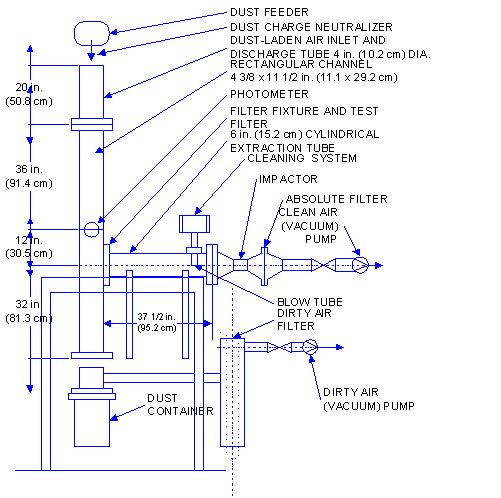Testing of Cleanable Filter Media Under Operating Conditions
The ETS test apparatus allows the user to measure baghouse filter media performance under defined conditions with regard to the filtration velocity (G/C), particle size distribution, and cleaning requirements. Filtration and cleaning conditions can be varied to simulate conditions that prevail in actual baghouse operations. Tests can be run with a standard dust (such as limestone or alumina), or customer supplied dust. Test data outputs include residual pressure drop, time between cleaning cycles, outlet dust concentration, and weight gain of the filter media. The procedure is ideal for comparing and selecting the proper filter media for a given application.
The test apparatus consists of a brush-type dust feeder that disperses test dust into a vertical rectangular duct (raw-gas channel). The dust feed rate is measured continuously and recorded via an electronic scale beneath the dust feed mechanism. A radioactive source is used to neutralize the dust before its entry into the raw-gas channel. An optical photo sensor monitors the concentration of dust and ensures that the flow is stable for the duration of the test. A portion of the gas flow is extracted from the raw-gas channel through the test filter, which is mounted vertically at the entrance to a horizontal duct (clean-gas channel). Two vacuum pumps maintain air flow through the raw-gas and clean-gas channels. The flow rates, and thus the filtration velocity (G/C) through the test filter, are kept constant using mass-flow controllers. The cleaning system consists of a compressed-air tank, a quick-action diaphragm valve, and a blow tube. Typically, the test consists of 100 filtration cycles. During a filtration cycle, the dust cake is allowed to form on the test filter until a preset differential pressure is reached. At this point, the test filter is cleaned by a pulse of compressed air from the clean-gas side. Residual pressure drop across the test filter is measured after the conclusion of the cleaning pulse. It is monitored and recorded continuously throughout the test.
To simulate long-term operation, the test filter can be subjected to a conditioning period, which consists of 10,000 rapid pulse cleaning cycles under continuous dust loading.
Outlet mass dust concentrations are measured using an absolute filter located downstream of the test filter at the end of the horizontal (clean-gas) duct. Particle size distribution of the emission can also be measured.

|